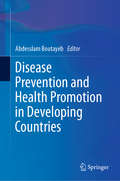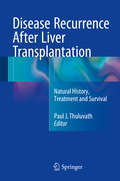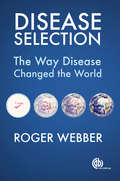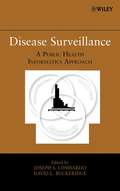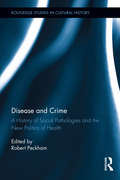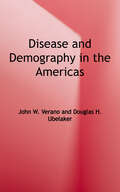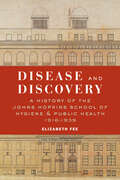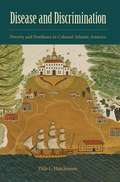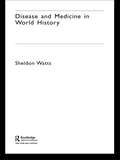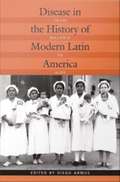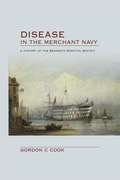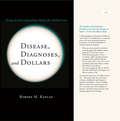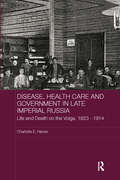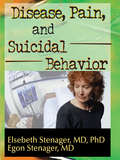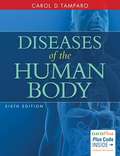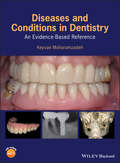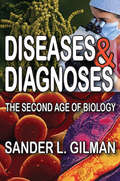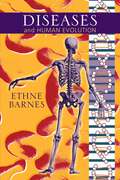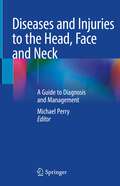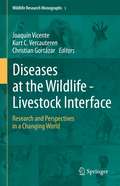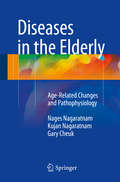- Table View
- List View
Disease Prevention and Health Promotion in Developing Countries
by Abdesslam BoutayebThis book brings together two important discussions in public health in developing countries: an understanding of the burden of disease, health equity and social determinants of health; and biomathematical models, epidemiological studies and estimation of the direct and indirect cost of disease. The empirical chapters in the first part discuss aspects of disease prevention and health promotion in developing countries, with a particular focus on countries that are part of the World Health Organization’s Eastern Mediterranean Region and the African Region. Health equity and social determinants of health constitute a cornerstone of this book, with the widespread recognition that addressing the social determinants of health is crucial not only for improving general health but importantly for reducing unfair and remediable health inequalities. Using mathematical models, epidemiological studies and statistical estimation of costs, the second part of this book shows the opportunities that exist for developing countries to prevent disease and promote health by adopting cost-effective strategies and cost–benefit analyses.
Disease Recurrence After Liver Transplantation
by Paul J. ThuluvathAs there is a high incidence of disease recurrence after liver transplantation, this volume is designed around the need for a reference text dealing exclusively with this problem. The book places special emphasis on pre- and post-transplant predictors of recurrence, severity assessment, prophylaxis, and treatment. Pathobiology of disease recurrence is discussed in detail where applicable. Issues including quality of life and cost burden are also covered in the text. Written by well-known authorities in each field, Disease Recurrence After Liver Transplantation: Natural History, Treatment and Survival serves as a comprehensive reference for physicians and surgeons who take care of liver transplant recipients and a major addition to the literature detailing the current understanding of disease recurrence.
Disease Selection
by Roger WebberDisease Selection: The way disease changed the world explores the host-pathogen relationship and the way communicable diseases have evolved often to stay one step ahead of interventions. From sexually transmitted disease through to ancient and modern great plagues, parasites, food, zoonoses, climate change and populations, this book explores the way disappeared and emergent diseases have shaped our world just as much as nature has. This book provides key information and is a valuable resource for students, practitioners and researchers working in global health and anyone interested in understanding of the basis of disease.
Disease Selection: The Way Disease Changed the World
by Roger WebberDiseases have had more influence on us than we realize. They have taken a major role in making us humans and probably determine the way we run our lives. They emerged with us from our ancestral home in Africa, to spread to the rest of the planet. History is full of the great epidemics of plague, smallpox and anthrax, with the present catastrophe of HIV that is changing the demography of the world in a similar way to its predecessors. We survived because of our genetic variation and immune system and it will be this that will save us again. So fundamental has been the part that disease has played in the world that it has brought about change, just as much as has natural selection. Actually disease has been another force, sometimes acting with natural selection but often in opposition. It continues to have a far more profound effect on all of us than realized, selecting the course of the world just as much as nature has.
Disease Surveillance: A Public Health Informatics Approach
by Joseph S. Lombardo David L. BuckeridgeAn up-to-date and comprehensive treatment of biosurveillance techniques With the worldwide awareness of bioterrorism and drug-resistant infectious diseases, the need for surveillance systems to accurately detect emerging epidemicsis essential for maintaining global safety. Responding to these issues, Disease Surveillance brings together fifteen eminent researchers in the fields of medicine, epidemiology, biostatistics, and medical informatics to define the necessary elements of an effective disease surveillance program, including research, development, implementation, and operations. The surveillance systems and techniques presented in the text are designed to best utilize modern technology, manage emerging public health threats, and adapt to environmental changes. Following a historical overview detailing the need for disease surveillance systems, the text is divided into the following three parts: Part One sets forth the informatics knowledge needed to implement a disease surveillance system, including a discussion of data sources currently used in syndromic surveillance systems. Part Two provides case studies of modern disease surveillance systems, including cases that highlight implementation and operational difficulties as well as the successes experienced by health departments in the United States, Canada, Europe, and Asia. Part Three addresses practical issues concerning the evaluation of disease surveillance systems and the education of future informatics and disease surveillance practitioners. It also assesses how future technology will shape the field of disease surveillance. This book's multidisciplinary approach is ideal for public health professionals who need to understand all the facets within a disease surveillance program and implement the technology needed to support surveillance activities. An outline of the components needed for a successful disease surveillance system combined with extensive use of case studies makes this book well-suited as a textbook for public health informatics courses
Disease Surveillance: Technological Contributions to Global Health Security
by David L. Blazes Sheri H. LewisDisease Surveillance: Technological Contributions to Global Health Security reminds us of the continued vulnerability of the world to contagious infections. The book presents examples of disease surveillance systems and evaluates promising advances as well as opportunities for new systems. It also explains how newer technologies can allow countries
Disease and Crime: A History of Social Pathologies and the New Politics of Health (Routledge Studies in Cultural History #23)
by Robert PeckhamDisease and crime are increasingly conflated in the contemporary world. News reports proclaim "epidemics" of crime, while politicians denounce terrorism as a lethal pathological threat. Recent years have even witnessed the development of a new subfield, "epidemiological criminology," which merges public health with criminal justice to provide analytical tools for criminal justice practitioners and health care professionals. Little attention, however, has been paid to the historical contexts of these disease and crime equations, or to the historical continuities and discontinuities between contemporary invocations of crime as disease and the emergence of criminology, epidemiology, and public health in the second half of the nineteenth century. When, how and why did this pathologization of crime and criminalization of disease come about? This volume addresses these critical questions, exploring the discursive construction of crime and disease across a range of geographical and historical settings.
Disease and Demography in the Americas
by John W. Verano Douglas H. UbelakerFeaturing 25 essays, this landmark book brings together the diverse views of leading international anthropologists and demographers on the patterns of populations and disease in the Americas both before and after 1492.
Disease and Discovery: A History of the Johns Hopkins School of Hygiene & Public Health, 1916–1939
by Elizabeth FeeThe story of a world-renowned institution and “a broad investigation of early twentieth-century public health ideology in America” (Journal of the American Medical Association).At the end of the nineteenth century, public health was the province of part-time political appointees and volunteer groups of every variety. Public health officers were usually physicians, but they could also be sanitary engineers, lawyers, or chemists—there was little agreement about the skills and knowledge necessary for practice. In Disease and Discovery, Elizabeth Fee examines the conflicting ideas about public health’s proper subject and scope and its search for a coherent professional unity and identity. She draws on the debates and decisions surrounding the establishment of what was initially known as the Johns Hopkins School of Hygiene and Public Health, the first independent institution for public health research and education, to crystallize the fundamental questions of the field.Many of the issues of public health education in the early twentieth century are still debated today. What is the proper relationship of public health to medicine? What is the relative importance of biomedical, environmental, and sociopolitical approaches to public health? Should schools of public health emphasize research skills over practical training? Should they provide advanced training and credentials for the few or simpler educational courses for the many?Fee explores the many dimensions of these issues in the context of the founding of the Johns Hopkins school. She details the efforts to define the school’s structure and purpose, select faculty and students, and organize the curriculum, and she follows the school’s growth and adaptation to the changing social environment through the beginning of World War II. As Fee demonstrates, not simply in its formation but throughout its history, the School of Hygiene served as a crucible for the forces shaping the public health profession as a whole.
Disease and Discovery: A History of the Johns Hopkins School of Hygiene and Public Health, 1916–1939
by Elizabeth FeeThe story of the founding and early years of the nation’s first dedicated school of public health has been reissued to coincide with the school’s centennial celebration.At the end of the nineteenth century, public health was the province of part-time political appointees and volunteer groups of every variety. Public health officers were usually physicians, but they could also be sanitary engineers, lawyers, or chemists—there was little agreement about the skills and knowledge necessary for practice. In Disease and Discovery, Elizabeth Fee examines the conflicting ideas about public health’s proper subject and scope and its search for a coherent professional unity and identity. She draws on the debates and decisions surrounding the establishment of what was initially known as the Johns Hopkins School of Hygiene and Public Health, the first independent institution for public health research and education, to crystallize the fundamental questions of the field. Many of the issues of public health education in the early twentieth century are still debated today. What is the proper relationship of public health to medicine? What is the relative importance of biomedical, environmental, and sociopolitical approaches to public health? Should schools of public health emphasize research skills over practical training? Should they provide advanced training and credentials for the few or simpler educational courses for the many? Fee explores the many dimensions of these issues in the context of the founding of the Johns Hopkins school. She details the efforts to define the school’s structure and purpose, select faculty and students, and organize the curriculum, and she follows the school’s growth and adaptation to the changing social environment through the beginning of World War II. As Fee demonstrates, not simply in its formation but throughout its history the School of Hygiene served as a crucible for the forces shaping the public health profession as a whole.
Disease and Discrimination: Poverty and Pestilence in Colonial Atlantic America
by Dale L. HutchinsonChoice Outstanding Academic Title Disease and discrimination are processes linked to class in the early American colonies. Many early colonists fell victim to mass sickness as Old and New World systems collided and new social, political, economic, and ecological dynamics allowed disease to spread.Dale Hutchinson argues that most colonists, slaves, servants, and nearby Native Americans suffered significant health risks due to their lower economic and social status. With examples ranging from indentured servitude in the Chesapeake to the housing and sewage systems of New York to the effects of conflict between European powers, Hutchinson posits that poverty and living conditions, more so than microbes, were often at the root of epidemics.
Disease and Medicine in World History (Themes in World History)
by Sheldon WattsDisease and Medicine in World History is a concise introduction to diverse ideas about diseases and their treatment throughout the world. Drawing on case studies from ancient Egypt to present-day America, Asia and Europe, this survey discusses concepts of sickness and forms of treatment in many cultures. Sheldon Watts shows that many medical practices in the past were shaped as much by philosophers and metaphysicians as by university-trained doctors and other practitioners. Subjects covered include: Pharaonic Egypt and the pre-conquest New World the evolution of medical systems in the Middle East health and healing on the Indian subcontinent medicine and disease in China the globalization of disease in the modern world the birth and evolution of modern scientific medicine. This volume is a landmark contribution to the field of world history. It covers the principal medical systems known in the world, based on extensive original research. Watts raises questions about globalization in medicine and the potential impact of infectious diseases in the present day.
Disease in the History of Modern Latin America: From Malaria to AIDS
by Diego ArmusChallenging traditional approaches to medical history, Disease in the History of Modern Latin America advances understandings of disease as a social and cultural construction in Latin America. This innovative collection provides a vivid look at the latest research in the cultural history of medicine through insightful essays about how disease--whether it be cholera or aids, leprosy or mental illness--was experienced and managed in different Latin American countries and regions, at different times from the late nineteenth century to the present. Based on the idea that the meanings of sickness--and health--are contestable and subject to controversy, Disease in the History of Modern Latin America displays the richness of an interdisciplinary approach to social and cultural history. Examining diseases in Mexico, Brazil, Argentina, Colombia, Peru, and Bolivia, the contributors explore the production of scientific knowledge, literary metaphors for illness, domestic public health efforts, and initiatives shaped by the agendas of international agencies. They also analyze the connections between ideas of sexuality, disease, nation, and modernity; the instrumental role of certain illnesses in state-building processes; welfare efforts sponsored by the state and led by the medical professions; and the boundaries between individual and state responsibilities regarding sickness and health. Diego Armus's introduction contextualizes the essays within the history of medicine, the history of public health, and the sociocultural history of disease. Contributors. Diego Armus, Anne-Emanuelle Birn, Kathleen Elaine Bliss, Ann S. Blum, Marilia Coutinho, Marcus Cueto, Patrick Larvie, Gabriela Nouzeilles, Diana Obregn, Nancy Lays Stepan, Ann Zulawski
Disease in the Merchant Navy: A History of the Seamen's Hospital Society
by Gordon Cook Anna PavlovIn this unique, highly detailed examination, Gordon C Cook explores disease in the merchant navy through the history of the Seamen's Hospital Society. From its foundation in 1812, until the present day, the Seamen's Hospital Society has been responsible for the physical welfare of merchant seamen and has headed many remarkable advances in medical science. This handsome volume is ideal for all those with an interest in the Seamen's Hospital Society, medical and naval historians, and general readers with an interest in maritime and naval history.
Disease, Diagnoses, and Dollars
by Robert M. KaplanHere's a conundrum: the U.S. health care system is the largest sector in the biggest economy in the world, and the US spends significantly more per capita on health care than any other country. Yet it ranks last among comparison nations on the major health indicators. Robert Kaplan attempts to tackle these anomalies head-on by taking the controversial position that mass markets have been created for services that may offer little or no benefit to patients. Kaplan forcefully argues that the overuse of medications and tests runs up the costs of health care, and offers potential solutions for policy makers and for patients.
Disease, Health Care and Government in Late Imperial Russia: Life and Death on the Volga, 1823-1914 (BASEES/Routledge Series on Russian and East European Studies)
by Charlotte E. HenzeThis book addresses fundamental issues about the last decades of Tsarist Russia, contributing significantly to current debates about how far and how successfully modernisation was being implemented by the Tsarist regime. It focuses on successive outbreaks of cholera in the city of Saratov on the Volga, in particular contrasting the outbreak of 1892 - widely regarded at the time as a national fiasco and a transformative episode for the Russian Empire - with the cholera epidemics of 1904-1910 when - despite completely new scientific discoveries and administrative arrangements - Russia suffered another national outbreak of the disease. The book sets these outbreaks fully in their social, economic, political and cultural context, and explains why a medical and social disaster - which had long since been overcome in other parts of Europe - continued much later in Russia. It explores autocratic government, urban renewal, public health, and disaster management, including the management of widespread public hysteria and social unrest. The book further analyses the assimilation of Western medical knowledge, and the resulting institutional and epistemological changes. Overall, it demonstrates that Russia’s medical history was inseparably linked to the nature of the tsarist regime itself in its confrontation with modernity.
Disease, Pain, and Suicidal Behavior
by Elsebeth StenagerEstimating the risk for suicidal behavior among patients is often a very complex challenge for psychiatrists, general practitioners, psychologists, surgeons, specialists in internal medicine, neurologists, nurses, and social workers. Disease, Pain, and Suicidal Behavior is designed to help you understand the methodological problems involved in the assessment of risk for suicidal behavior in patients with various somatic and psychiatric disorders so you can establish effective approaches to the psychosocial treatment of endangered patients. Through the book’s comprehensive and insightful discussions, you will even learn specific strategies for improving the quality of life of such patients.Disease, Pain, and Suicidal Behavior discusses psychiatric disorders such as depression, schizophrenia, personality disorders, anxiety disorders, and alcohol and drug abuse as risk factors for suicidal behavior. From its helpful and clearly written pages, you will also learn about the role of social factors in suicidal behavior and the relationship between suicidal behavior and biological factors. Perhaps most important of all, you will learn which groups of patients and which disorders are associated with the highest risk of suicide through the book’s critical discussions of: the lifetime risk of suicide in depressed patients the stages of diseases like multiple sclerosis and the strains placed on the patient young male schizophrenics and their vulnerability to self-destructive acts mortality in patients with spinal cord injuries forced reduction in daily activities for patients with heart and lung conditions and resulting emotional instability the high risk of suicide immediately after a cancer diagnosis is given identifying risk factors for a second attempt at suicide questions to ask those at risk for suicidal behaviorRecognizing which of your patients run the risk of committing suicide can be an overwhelming task because of the multiplicity of factors involved. Disease, Pain, and Suicidal Behavior, because it examines critically the existing literature and studies on suicide and suicide risk, can help you evaluate and prevent suicidal behavior in a timely manner. You will turn the last of its pages with a much improved understanding of which illnesses and sufferings present an increased risk of suicidal behavior.
Disease, War, and the Imperial State: The Welfare of the British Armed Forces during the Seven Years' War
by Erica ChartersThe Seven YearsOCO War, often called the first global war, spanned North America, the West Indies, Europe, and India. a In these locations diseases such as scurvy, smallpox, and yellow fever killed far more than combat did, stretching the resources of European states. Ina"Disease, War, and the Imperial State," Erica Charters demonstrates how disease played a vital role in shaping strategy and campaigning, British state policy, and imperial relations during the Seven YearsOCO War. Military medicine was a crucial component of the British war effort; it was central to both eighteenth-century scientific innovation and the moral authority of the British state. Looking beyond the traditional focus of the British state as a fiscal war-making machine, Charters uncovers an imperial state conspicuously attending to the welfare of its armed forces, investing in medical research, and responding to local public opinion. a Charters shows military medicine to be a credible scientific endeavor that was similarly responsive to local conditions and demands. "Disease, War, and the Imperial State"ais an engaging study of early modern warfare and statecraft, one focused on the endless and laborious task of managing manpower in the face of virulent disease in the field, political opposition at home, and the clamor of public opinion in both Britain and its colonies. "
Diseases Of The Human Body (Sixth Edition)
by Carol D. Tamparo Marcia Marti A. LewisDiseases of the Human Body, 6th edition, is carefully designed to meet the unique educational and professional needs of health-care personnel. The book focuses on human diseases and disorders that are frequently first diagnosed or treated in ambulatory health care. Each entry considers what the disease or disorder is, how it might be diagnosed and treated, and the likely consequences of the disease or disorder for the person experiencing it.
Diseases and Conditions in Dentistry: An Evidence-Based Reference
by Keyvan MoharamzadehDiseases and Conditions in Dentistry: An Evidence-Based Reference is the ideal, one-stop guide for dentistry clinicians to keep at their side. Provides a quick reference for the busy clinician covering diseases and conditions in endodontics, periodontics, prosthodontics and restorative dentistry Offers identically formatted chapters following the same clear and concise layout with detailed clinical cases and evidence-based discussions Features a companion website with additional clinical photographs, radiographs, and case notes
Diseases and Diagnoses: The Second Age of Biology
by Sander L. GilmanDiseases and Diagnoses discusses why such social problems as addiction, sexually transmitted diseases, racial predisposition for illness, surgery and beauty, and electrotherapy, all of which concerned thinkers a hundred years ago, are reappearing at a staggering rate and in diverse national contexts. In the twentieth century such problems were viewed as only historical concerns. Yet in the twenty-first century, we once again find ourselves confronting their implications. In this fascinating volume, Gilman looks at historical and contemporary debates about the stigma associated with biologically transmitted diseases. He shows that there is no indisputable way to measure when a disease or therapy will reappear, or how it may be perceived at any given moment in time. Consequently, Gilman focuses on the socio-cultural and political implications that the reappearance of such diseases has had on contemporary society. His approach is to show how culture (embedded in cultural objects) both feeds and is fed by the claims of medical science-as for example, the reappearance of "race" as a cultural as well as a medical category. If the twentieth century was the "age of physics," in the latter part of the past century and certainly in the twenty-first century biological concerns are recapturing central stage. Achievements of the biological sciences are changing the public's sense of what constitutes cutting-edge science and medicine. None has captured the public imagination more effectively than the mapping of the human genome and the promise of genetic manipulation, which fuel what Gilman calls a "second age of biology." Although not without controversy, the role of genetics appears to be key. Gilman puts contemporary debates in historical context, showing how they feed social and cultural concerns as well as medical possibilities.
Diseases and Human Evolution
by Ethne BarnesUrgent interest in new diseases, such as the coronavirus, and the resurgence of older diseases like tuberculosis has fostered questions about the history of human infectious diseases. How did they evolve? Where did they originate? What natural factors have stalled the progression of diseases or made them possible? How does a microorganism become a pathogen? How have infectious diseases changed through time? What can we do to control their occurrence? ;Ethne Barnes offers answers to these questions, using information from history and medicine as well as from anthropology. She focuses on changes in the patterns of human behavior through cultural evolution and how they have affected the development of human diseases. ;Writing in a clear, lively style, Barnes offers general overviews of every variety of disease and their carriers, from insects and worms through rodent vectors to household pets and farm animals. She devotes whole chapters to major infectious diseases such as leprosy, syphilis, smallpox, and influenza. Other chapters concentrate on categories of diseases (gut bugs, for example, including cholera, typhus, and salmonella). The final chapters cover diseases that have made headlines in recent years, among them mad cow disease, West Nile virus, and Lyme disease. ;In the tradition of Berton Roueché, Hans Zinsser, and Sherwin Nuland, Ethne Barnes answers questions you never knew you had about the germs that have threatened us throughout human history.
Diseases and Injuries to the Head, Face and Neck: A Guide to Diagnosis and Management
by Michael PerryThis book provides a practically applicable guide to injuries, diseases, and disorders affecting the head, neck, and dental region seen within accident and emergency departments. These regions contain a number of specialized structures each with individual neural, muscular and vascular elements, meaning that the study of these anatomical areas is complicated and often quite daunting. Chapters in this work aim to break the treatment of such injuries and diseases into an easy-to-digest format via chapters featuring a symptom-based approach. Therefore, enabling the reader to quickly access the information they require when treating patients with a variety of disorders in the emergency room. Diseases and Injuries to the Head, Face and Neck: A Guide to Diagnosis and Management is a concise overview of how to deal with head, neck, and dental emergencies and is an important up-to-date resource for all medical professionals and trainees who encounter these patients.
Diseases at the Wildlife - Livestock Interface: Research and Perspectives in a Changing World (Wildlife Research Monographs #3)
by Joaquín Vicente Kurt C. Vercauteren Christian GortázarShared diseases among wildlife, livestock and humans, often transboundary, are relevant to public health and global economy, as being highlighted currently relative to the global COVID19 pandemic. Diseases at these interfaces also impact the conservation of biodiversity and must be considered when managing wildlife. While wildlife and domestic livestock have coexisted in dynamic systems for thousands of years, spillover disease risks are higher today than in the past due to global patterns of increasing close contact and interactions among wildlife, livestock and humans in the context of complex, diverse and numerous circumstances. Multidisciplinary studies of animal interfaces, especially those involving wildlife, therefore, must be brought to the forefront so that knowledge gaps can be realized and filled to inform managers and policy makers.In the first part of the book authors illustrate and discuss ecological and epidemiological concepts related to the interfaces, with a vision towards socio-ecological system health. In addition, the history of past animal interfaces provides the necessary perspective to focus current questions, better understand present situations, and informs how we can best approach the future. The second part discusses the myriad of similar and differing wildlife- livestock interfaces found around the world from a regional point of view. The third part focuses on how to assess the spatial and temporal overlap between livestock and wildlife, and authors present new technical innovations about how inter-transmissions between wild and domestic populations can be quantified. An overview of main modeling approaches available to quantify multi-host disease transmission at the wildlife/livestock interface, illustrated with specific-case studies, is also presented. Finally, the need for interdisciplinary approaches and a dedicated thematic field to approach the wildlife/livestock interfaces and create opportunities to promote wildlife–livestock coexistence is emphasized. The concluding chapter presents perspectives and directions to better understanding disease dynamics at the wildlife/livestock interface, global change and implications for the future. The changing distribution of interfaces, ongoing human and environmental changes (e. g. climate warming, changes in animal production systems, etc.) and their likely impacts and consequences for the interfaces and disease transmission processes are all discussed.
Diseases in the Elderly
by Nages Nagaratnam Kujan Nagaratnam Gary CheukThis book provides a comprehensive overview of the two important issues relating to disease in elderly: the age-related changes and the pathophysiology of the diseases. The book contains 19 chapters that are arranged by organ system and structured to cover the specific areas for a quick but in-depth understanding of diseases in aging patients. Unlike any other book on the market, this text is concise and yet thorough in approach to the stipulated areas. This book includes multiple-choice questions that reinforce the concepts that are most vital to understanding and treating geriatric patients, making it an outstanding resource on its own or as a companion to larger geriatric texts. Diseases in the Elderly is the ultimate resource for geriatricians, medical students, primary care physicians, hospital doctors, geriatric nurses, and all other medical professionals treating and diagnosing diseases in elderly patients.
